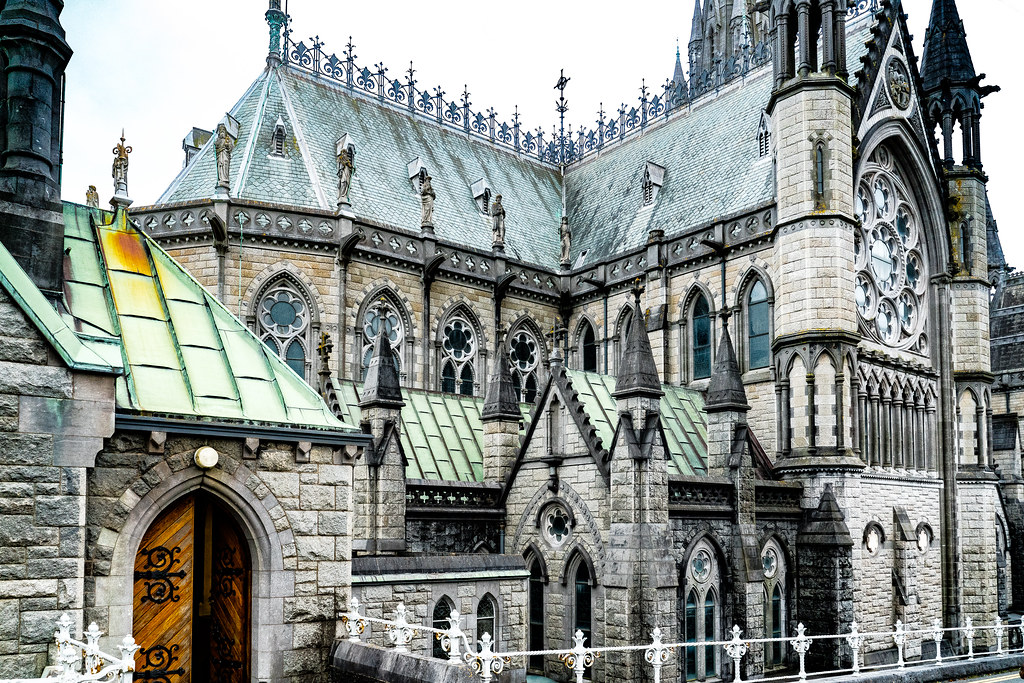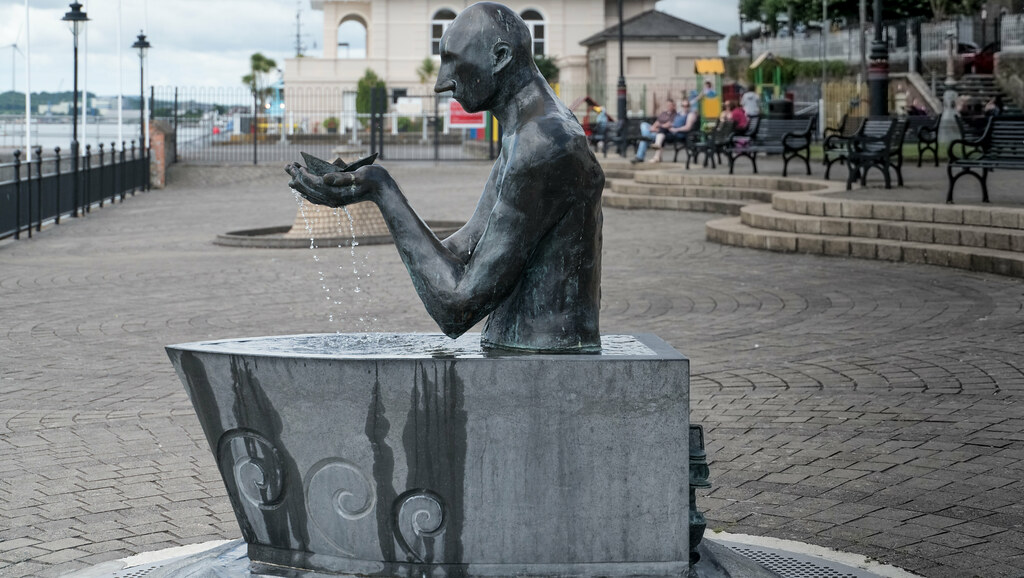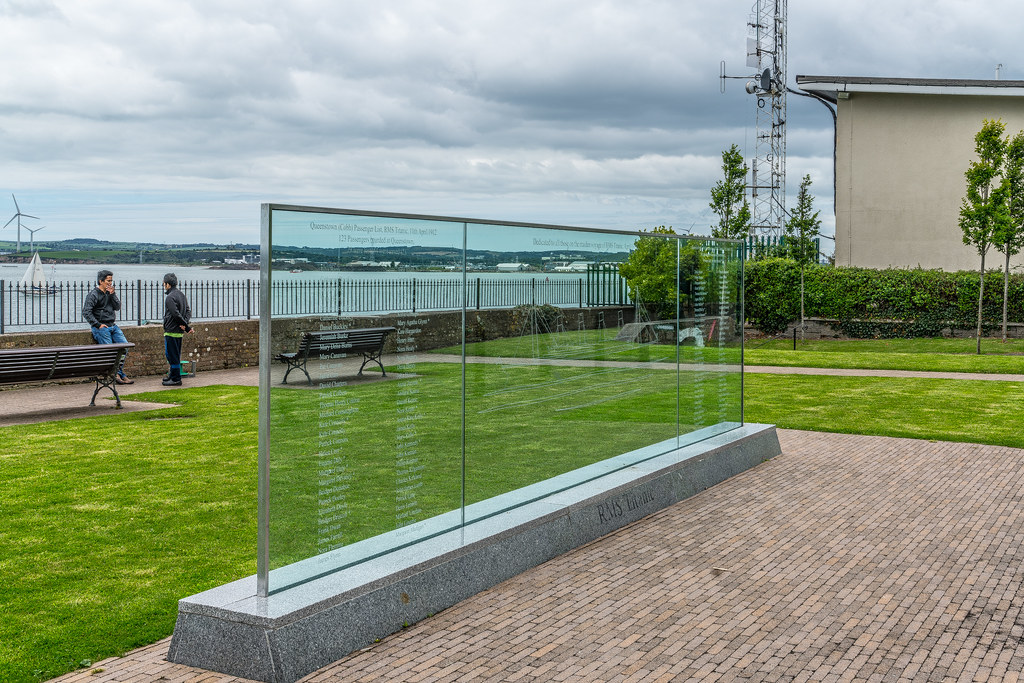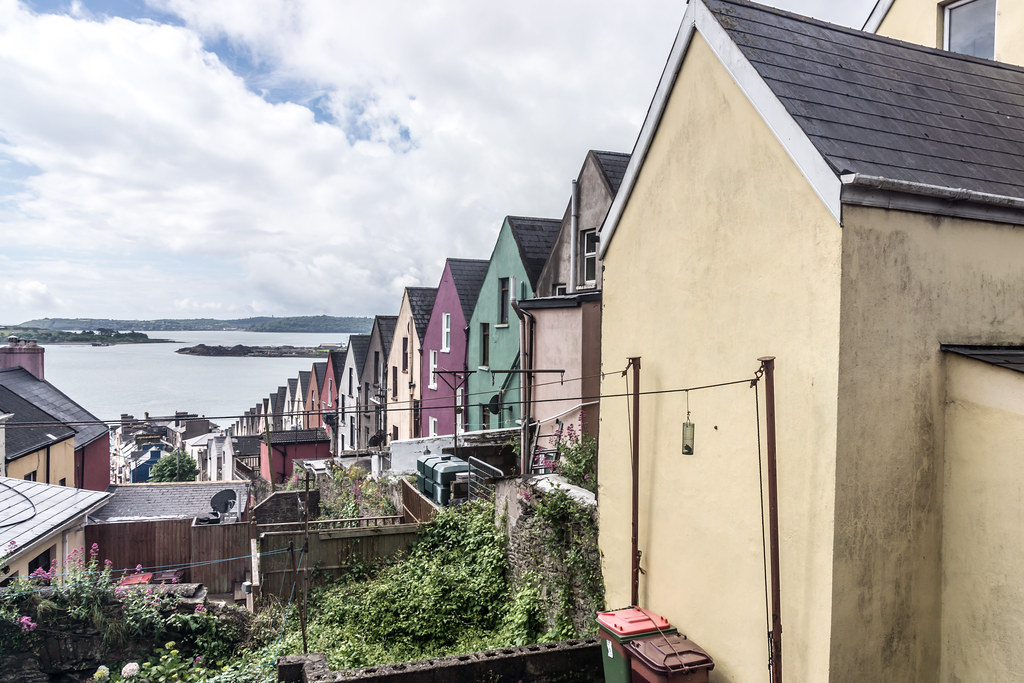THE TOWN OF COBH
Cobh, known from 1850 until the late 1920s as Queenstown, is a tourist seaport town on the south coast of County Cork, Ireland. Cobh is on the south side of Great Island in Cork Harbour and is home to Ireland's only dedicated cruise terminal. Tourism in the area draws on the maritime and emigration legacy of the town - including its association with the RMS Titanic.
Facing the town are Spike Island and Haulbowline Island, and on a high point in the town stands St Colman's Cathedral, one of the tallest buildings in Ireland and seat of the diocese of Cloyne.
International upheaval led to Cobh experiencing rapid development in the early 19th century. Due to the natural protection enjoyed thanks to its harbour setting, the town became important as a tactical centre for naval military base purposes, never more so than at the time of the Napoleonic Wars between France and Britain. Today, the Irish Naval Service headquarters is based on Haulbowline island facing Cobh.
The wars against the French led to the town becoming a British Naval port with its own admiral, and many of the present-day buildings date from this time. The eventual cessation of hostilities dented Cobh's prosperity for a while but it soon became known as a health resort, and many convalescents came to avail themselves of its temperate climate. Notable amongst these people was Charles Wolfe who wrote "The Burial of Sir John Moore After Corunna". Wolfe is buried in the Old Church Cemetery outside the town.
One of the major transatlantic Irish ports, the former Queenstown was the departure point for 2.5 million of the six million Irish people who emigrated to North America between 1848 and 1950. On 11 April 1912, Queenstown was famously the final port of call for the RMS Titanic when she set out across the Atlantic on her ill-fated maiden voyage. She was assisted by the PS America and the PS Ireland, two ageing White Star Line tenders, along with several other smaller boats delivering first-class luggage. Local lore has it that a Titanic crew member, John Coffey, a native of Queenstown, jumped ship, although there is no record of his name on the crew list. 123 passengers boarded in all; only 44 survived the sinking.
Cobh was also a major embarkation port for men, women and children who were deported to penal colonies such as Australia. The records of such deportations can be found in ships' log books in the Cobh Museum, which since 1973 has been housed in Scots church (a Presbyterian church until its 1969 closure) overlooking the harbour.
A significant shipbuilding industry was developed in the town, and the remnants of the Verolme Shipyard today maintain many of the original cranes and hoists now forming part of an industrial and maritime heritage.
During First World War, Queenstown was a naval base for British and American destroyers operating against the U-boats that preyed upon Allied merchant shipping. Q-ships (heavily armed merchant ships with concealed weaponry, designed to lure submarines into making surface attacks) were called Q-ships precisely because many were, in fact, fitted-out in Queenstown. The first division of American destroyers arrived in May 1917, and the sailors who served on those vessels were the first American servicemen to see combat duty in the war. When that first convoy arrived in port after enduring a rough passage in what were little more than open boats, its members were met by a crowd of sailors and townspeople, thankful for their anticipated help towards stopping the U-boats that were blockading western Europe. The British commodore present met the captain of the American flagship, jumping onto the dock and asking how soon the weather-beaten American ships could be put to use. "We're ready now, sir!" was the widely quoted answer from the American.
The United States Navy established the Queenstown Naval Air Station on 22 February 1918 to operate flying boats. This naval air station closed shortly after the Armistice of 11 November 1918.
Due to its tactical military importance, under the terms of the 1921 Anglo-Irish Treaty the port remained a UK sovereign base. Along with the other Treaty Ports it was handed over to the government of the Irish Free State in 1938.
Tourism is a large employer in Cobh. Large cruise liners visit Cobh each year, mainly during the summer months, although many of the tourists are transported out of Cobh by bus to other tourist destinations. In all, almost 100,000 cruise liner passengers and crew arrive in the town each year when their ships berth right in the centre of the town at Ireland's only dedicated cruise terminal.
Tourist attractions are focused on the maritime and emigration legacy of the town and include the Queenstown Story Heritage Centre, Titanic Experience, Titanic Trail walking tour, Cobh Museum, Cobh Road Train, Spike Island tours and St Colman's Cathedral. The town has remained largely unchanged since RMS Titanic departed from Cork Harbour in 1912, with the streetscape and piers still much the same. Facing the town are Spike Island and Haulbowline Island. The latter is the headquarters of the Irish Naval Service, formerly a British naval base.
Cobh was home to Ireland's only steelworks, the former state-owned Irish Steel works which was closed by its buyer, Ispat International, in 2001. There is a controversy over the slag heap on the steelworks, where there are concerns that it may be leaching into the harbour. Another important employer in Cobh was the Dutch-owned Verolme Cork Dockyard, in Rushbrooke. It opened in 1960 but ceased operations in the mid-1980s. In 1981 the MV Leinster was built at Verolme for service on the Dublin – Holyhead route. The last ship built at Verolme was the Irish Naval Service's LÉ Eithne (P31).Some ship repair work is still carried at Rushbrooke using the drydock and other facilities. The drydock pumps are reputed to date from 1912.
Facing the town are Spike Island and Haulbowline Island, and on a high point in the town stands St Colman's Cathedral, one of the tallest buildings in Ireland and seat of the diocese of Cloyne.
International upheaval led to Cobh experiencing rapid development in the early 19th century. Due to the natural protection enjoyed thanks to its harbour setting, the town became important as a tactical centre for naval military base purposes, never more so than at the time of the Napoleonic Wars between France and Britain. Today, the Irish Naval Service headquarters is based on Haulbowline island facing Cobh.
The wars against the French led to the town becoming a British Naval port with its own admiral, and many of the present-day buildings date from this time. The eventual cessation of hostilities dented Cobh's prosperity for a while but it soon became known as a health resort, and many convalescents came to avail themselves of its temperate climate. Notable amongst these people was Charles Wolfe who wrote "The Burial of Sir John Moore After Corunna". Wolfe is buried in the Old Church Cemetery outside the town.
One of the major transatlantic Irish ports, the former Queenstown was the departure point for 2.5 million of the six million Irish people who emigrated to North America between 1848 and 1950. On 11 April 1912, Queenstown was famously the final port of call for the RMS Titanic when she set out across the Atlantic on her ill-fated maiden voyage. She was assisted by the PS America and the PS Ireland, two ageing White Star Line tenders, along with several other smaller boats delivering first-class luggage. Local lore has it that a Titanic crew member, John Coffey, a native of Queenstown, jumped ship, although there is no record of his name on the crew list. 123 passengers boarded in all; only 44 survived the sinking.
Cobh was also a major embarkation port for men, women and children who were deported to penal colonies such as Australia. The records of such deportations can be found in ships' log books in the Cobh Museum, which since 1973 has been housed in Scots church (a Presbyterian church until its 1969 closure) overlooking the harbour.
A significant shipbuilding industry was developed in the town, and the remnants of the Verolme Shipyard today maintain many of the original cranes and hoists now forming part of an industrial and maritime heritage.
During First World War, Queenstown was a naval base for British and American destroyers operating against the U-boats that preyed upon Allied merchant shipping. Q-ships (heavily armed merchant ships with concealed weaponry, designed to lure submarines into making surface attacks) were called Q-ships precisely because many were, in fact, fitted-out in Queenstown. The first division of American destroyers arrived in May 1917, and the sailors who served on those vessels were the first American servicemen to see combat duty in the war. When that first convoy arrived in port after enduring a rough passage in what were little more than open boats, its members were met by a crowd of sailors and townspeople, thankful for their anticipated help towards stopping the U-boats that were blockading western Europe. The British commodore present met the captain of the American flagship, jumping onto the dock and asking how soon the weather-beaten American ships could be put to use. "We're ready now, sir!" was the widely quoted answer from the American.
The United States Navy established the Queenstown Naval Air Station on 22 February 1918 to operate flying boats. This naval air station closed shortly after the Armistice of 11 November 1918.
Due to its tactical military importance, under the terms of the 1921 Anglo-Irish Treaty the port remained a UK sovereign base. Along with the other Treaty Ports it was handed over to the government of the Irish Free State in 1938.
Tourism is a large employer in Cobh. Large cruise liners visit Cobh each year, mainly during the summer months, although many of the tourists are transported out of Cobh by bus to other tourist destinations. In all, almost 100,000 cruise liner passengers and crew arrive in the town each year when their ships berth right in the centre of the town at Ireland's only dedicated cruise terminal.
Tourist attractions are focused on the maritime and emigration legacy of the town and include the Queenstown Story Heritage Centre, Titanic Experience, Titanic Trail walking tour, Cobh Museum, Cobh Road Train, Spike Island tours and St Colman's Cathedral. The town has remained largely unchanged since RMS Titanic departed from Cork Harbour in 1912, with the streetscape and piers still much the same. Facing the town are Spike Island and Haulbowline Island. The latter is the headquarters of the Irish Naval Service, formerly a British naval base.
Cobh was home to Ireland's only steelworks, the former state-owned Irish Steel works which was closed by its buyer, Ispat International, in 2001. There is a controversy over the slag heap on the steelworks, where there are concerns that it may be leaching into the harbour. Another important employer in Cobh was the Dutch-owned Verolme Cork Dockyard, in Rushbrooke. It opened in 1960 but ceased operations in the mid-1980s. In 1981 the MV Leinster was built at Verolme for service on the Dublin – Holyhead route. The last ship built at Verolme was the Irish Naval Service's LÉ Eithne (P31).Some ship repair work is still carried at Rushbrooke using the drydock and other facilities. The drydock pumps are reputed to date from 1912.
SORRY FOR THE DELAY
THE PHOTO DIARY IS NOT LIMITED TO CORK AS I ONLY VISIT THE CITY ONCE EVERY YEAR AND 2020 MAY BE AN EXCEPTION. I AM BASED IN DUBLIN BUT DURING THE SUMMER MONTHS I VISIT BELFAST, LIMERICK, GALWAY, KILKENNY AND WATERFORD AND USUALLY DEVOTE A WEEK TO PHOTOGRAPHING EACH OF THE CITIES IN QUESTION
Lume Cube Video Conference Lighting Kit AMAZON AFFILIATE LINK
- Lume Cube Video Conference Lighting Kit
- Video Conferencing | Remote Working
- Zoom Call Lighting | Self Broadcasting and Live Streaming
- ADJUSTABLE BRIGHTNESS: Control your lighting from 1% - 100% brightness to get the perfect lighting for your setup
- ADJUSTABLE COLOR TEMPERATURE: Adjust from a warm (orange) light to a cool (white) light to get your perfect skin tones and match your environment
- SOFT & PROFESSIONAL LIGHT: The built-in frosted lens and additional white diffuser give you the flexibility to soften your light and get that professional glow
- COMPUTER MOUNT INCLUDED: Use the included suction cup computer mount with Laptops, Desktops, or any flat surface!
- LONG BATTERY LIFE: The built-in extended battery provides hours of illumination. For extended broadcasting, you can plug the light in to your computers USB port and run indefinitely off of external power!"
You will find links to buy products from Amazon, Google and other partners. If you click on these links, you’ll find that the URL includes a small extra piece of text which identifies that the click came from my websites. This text is an affiliate code, and it means that I get a small percentage of the money you spend if you choose to buy that product, or, in some cases, other products from the site soon after. These affiliate links help pay the costs of producing my websites and ensure that the content is free to you.






